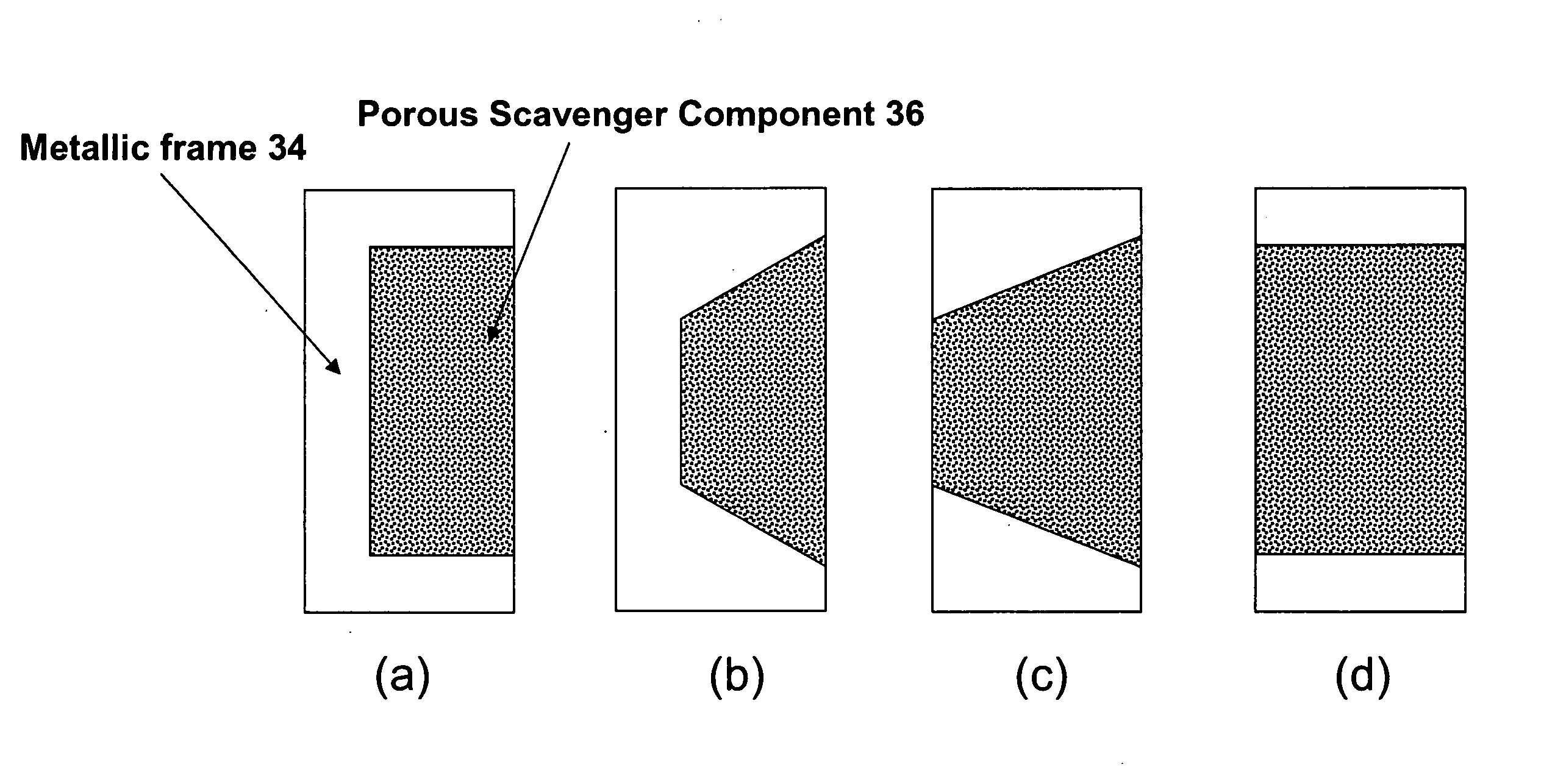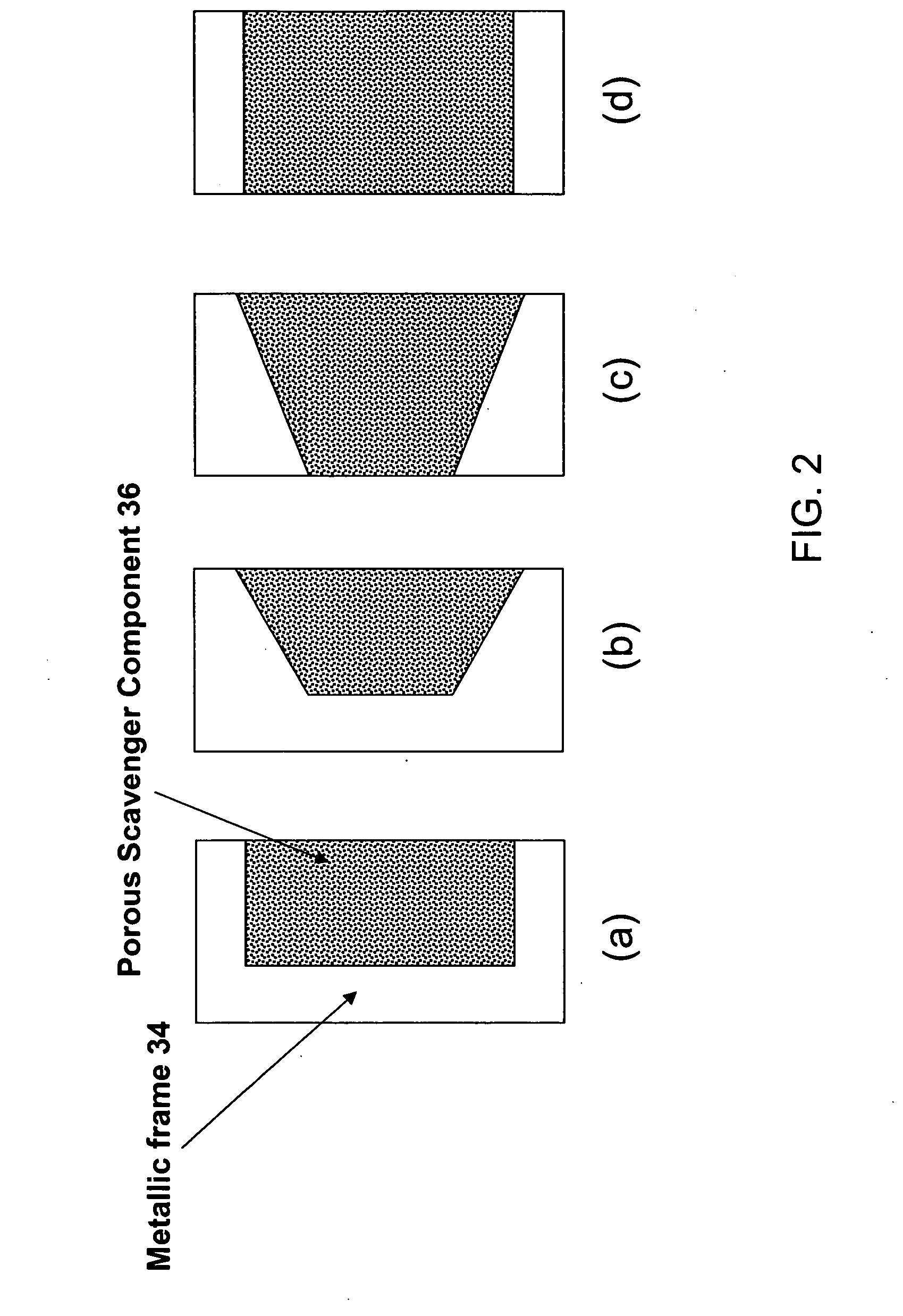Photomask assembly incorporating a metal/scavenger pellicle frame
a technology of pellicle frame and photomask, which is applied in the field of photomask assemblies, can solve the problems of destroying the patterns transferred to the chips, forming and growing ammonium sulfate crystals under continued laser exposure, and heating the photomask assembly, and achieves the effect of sufficient strength
- Summary
- Abstract
- Description
- Claims
- Application Information
AI Technical Summary
Benefits of technology
Problems solved by technology
Method used
Image
Examples
example 1
Metal Pellicle Frame and Machining of Windows
[0066] The following detailed description is an example of a composite pellicle frame configuration incorporating a through-machined window in each of its four sides, each window having a stepped shape and screwed flanges to hold a scavenger component in place. Such a pellicle frame is depicted in FIG. 2(d) and FIG. 4.
[0067] The machined metallic skeleton is formed from a standard metal pellicle frame. The type of frame (part number) is selected by the mask manufacturer based on the size of the reticle. The frame advantageously can have a black anodized finish. In constructing this embodiment of a pellicle frame, the windows preferably are machined prior to any such surface treatment.
[0068] As shown in FIG. 6, a window is machined into each of the pellicle frame's four side walls. The size of each window is determined with two objectives in mind: (1) retaining sufficient mechanical properties of the metallic frame; and (2) maximizing t...
example 2
Processing of Scavenger Components by Sol-Gel Process
[0070] In this example, a sol-gel process is used to prepare a silica scavenger component. In this process, a sol is prepared using hydrolyzed silicon alkoxide and fine silica particles (fumed silica, e.g., Aerosil OX-50 manufactured by Degussa Corporation, of Parsippany, N.J.), as described in published U.S. Patent Application Publication No. 2002 / 0157419 A1 to Ganguli et al., which is incorporated by reference herein. The wet gel obtained by gelation of this sol then is dried using a sub-critical drying process described in U.S. Pat. No. 5,473,826 to Kirkbir et al. This drying process minimizes shrinkage of the gel and decrease of pore size, and it also prevents cracking of the wet gel, which otherwise can occur during drying. Because the gel does not significantly shrink during drying, large crack-free monolithic porous articles having specified pore structures can be easily obtained.
[0071] In one embodiment of this example o...
example 3
Silica Scavenger Component
[0083] In this example, a sol-gel process is used to prepare a silica scavenger component. A sol was prepared using the method disclosed in Example 2 of U.S. Patent Application Publication No. 2002 / 0157419 A1 to Ganguli et al. This sol was cast into a square mold having inner dimensions of about 26.7 cm×26.7 cm, to a height of about 18 mm. After gelation, the gel was subcritically dried according to techniques disclosed in U.S. Pat. No. 5,473,826 to Kirkbir et al. The dried gel was free of any cracks.
[0084] To perform partial densification of the dry gel, the gel was placed in an electrically heated SiC furnace having a quartz enclosure. First, hydrocarbons and water vapor adsorbed on the dry gel surface were removed by heating the gel in an atmosphere containing about 7% oxygen and about 93% nitrogen. In this step, the gel was first heated from about 20° C. to about 170° C., at a heating rate of about 25° C. / hr, and the gel then was held at about 170° C....
PUM
| Property | Measurement | Unit |
|---|---|---|
| thickness | aaaaa | aaaaa |
| pore size | aaaaa | aaaaa |
| pore size | aaaaa | aaaaa |
Abstract
Description
Claims
Application Information
 Login to View More
Login to View More - R&D
- Intellectual Property
- Life Sciences
- Materials
- Tech Scout
- Unparalleled Data Quality
- Higher Quality Content
- 60% Fewer Hallucinations
Browse by: Latest US Patents, China's latest patents, Technical Efficacy Thesaurus, Application Domain, Technology Topic, Popular Technical Reports.
© 2025 PatSnap. All rights reserved.Legal|Privacy policy|Modern Slavery Act Transparency Statement|Sitemap|About US| Contact US: help@patsnap.com



